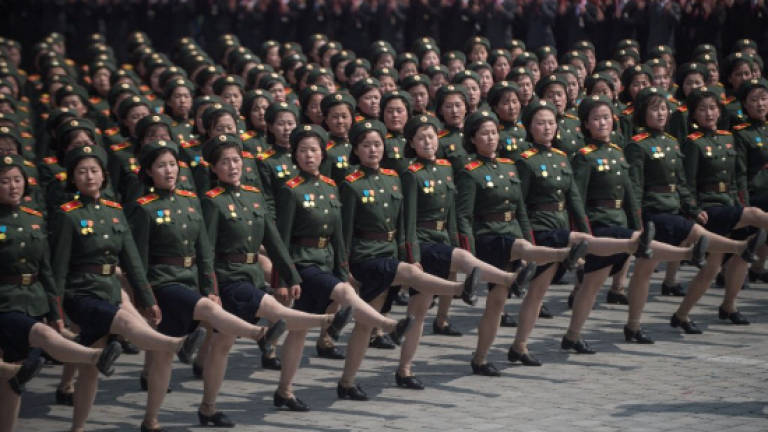N. Korea's army parade seeks to steal South's Olympic thunder

SEOUL: North Korea's planned military parade on the eve of the South's Winter Olympics is a carefully calculated move to use the global spotlight on the peninsula to reassert its military power, analysts say.
Pyongyang last month announced it would commemorate the 70th anniversary of the founding of its military on Feb 8 — changing the date from April 25 and switching it to the day before the Games' opening ceremony.
The news provoked consternation in Winter Games host South Korea, coming just days after the unpredictable, nuclear-armed North agreed to participate in Pyeongchang following months of cajoling by Seoul to join in a "peace Olympics".
The latest satellite imagery, taken Monday, showed 13,000 troops rehearsing at an training facility on the outskirts of Pyongyang, but with only a few artillery pieces and armoured vehicles, according to respected US website 38 North.
"The North last year declared itself as a nuclear state," said Park Won-Gon, international relations professor at Handong Global University.
"They want to 'normalise' its military rise and its status as a de-facto nuclear state by holding the parade and attending the Olympics a day later as if nothing happened and there is nothing wrong about it," he told AFP.
Such plans are likely to backfire.
The North's participation in the Games has been hailed by Seoul and the IOC but is seen with suspicion by critics who describe it as an attempt to soften Pyongyang's image and to eventually ease sanctions on the regime without it giving up its nuclear ambitions.
Washington has said it would "prefer" the parade not take place on Thursday, and US political website Axios quoted an aide to US Vice President Mike Pence — who will attend the Pyeongchang opening ceremony — calling the North's participation "propaganda".
"Everything the North Koreans do at the Olympics is a charade to cover up the fact that they are the most tyrannical and oppressive regime on the planet," the aide said.
Goose step
The Kim regime — which has ruled the isolated, impoverished nation for decades with an iron fist and pervasive personality cult — has proven adept at grabbing global attention for political purposes.
Pyongyang has often test-fired missiles or threatened to do so ahead of visits by high-profile diplomatic figures to Seoul, or around presidential elections or inaugurations in South Korea or the US.
North Korean military parades typically feature thousands of goose-stepping troops who make the ground shake as they pass through Kim Il Sung Square, rolling tanks and increasingly heavy weaponry, culminating most recently in April with intercontinental ballistic missiles (ICBMs) — or at least their casings.
They are the highlight for Pyongyang-watchers, who examine them closely for clues about the sources and progress of its technology.
The displays take place before an audience of tens of thousands of citizens, with leader Kim Jong-Un and the rest of the North Korean leadership looking on from a viewing platform.
Pyongyang normally invites in hundreds of foreign journalists to show off the spectacle to the world — although it has not done so on this occasion.
Kim appears to be seeking to rally support from his people by showcasing and portraying the North's military might as something to match the achievements of its richer southern neighbour, said Cheong Seong-Chang, analyst at the Sejong Institute think tank.
"The North can turn potential envy among its people over the Pyeongchang Winter Olympics around, saying 'we may be behind the South economically, but we are ahead of them militarily'," he said.
Slap in the face
In Seoul, the parade is seen as a slap in the face of the dovish South Korean President Moon Jae-In, who advocates engagement with the North and strongly pushed for the North's participation in the Games.
A Feb 8 parade, 38 North said, would "likely warrant much criticism from sceptics of inter-Korean dialogue. However, for domestic audiences, it would cap off a year of dramatic progress in North Korea's nuclear and ballistic missile programmes".
The displays typically take months to prepare, suggesting that the decision to put it on was taken some time last year.
But the indications suggest the parade will be smaller than last April's — Pyongyang is brutally cold in Feb — and so far no missiles have been spotted.
The absence of foreign journalists could be driven by a desire to control how it is portrayed, and South Korean Prime Minister Lee Nak-Yeon told lawmakers that the North was "trying to avoid giving an impression that it poses provocations to the international community".
Pyongyang said Monday it would send a high-level delegation led by its ceremonial head of state, Kim Yong-Nam, to attend the opening ceremony.
"The parade is most likely aimed at showing off its new status as a nuclear power," South Korea's JoongAng daily said in an editorial Monday.
"We need to welcome North Korean athletes, but must not beg for dialogue," it added. — AFP